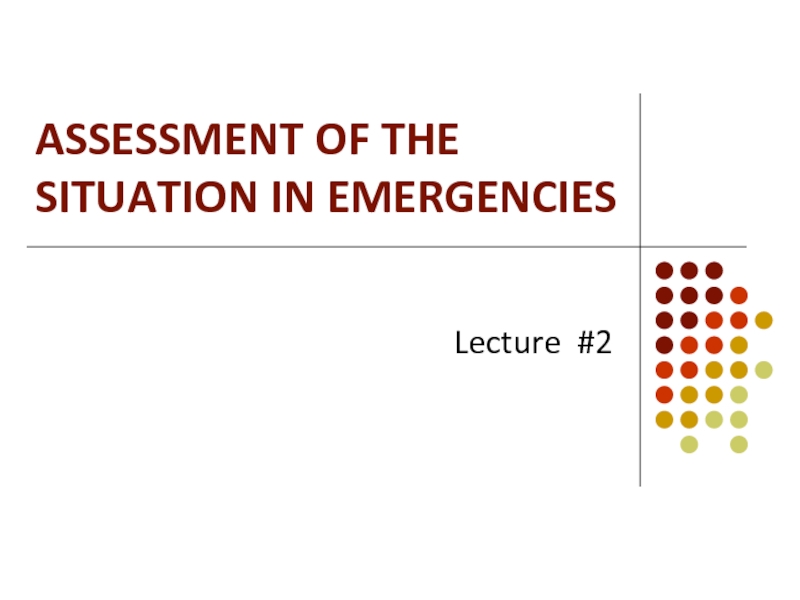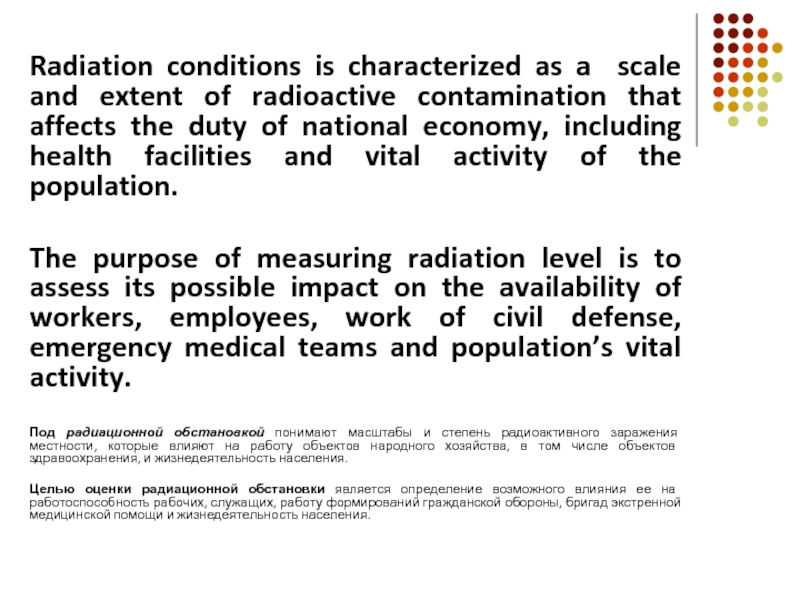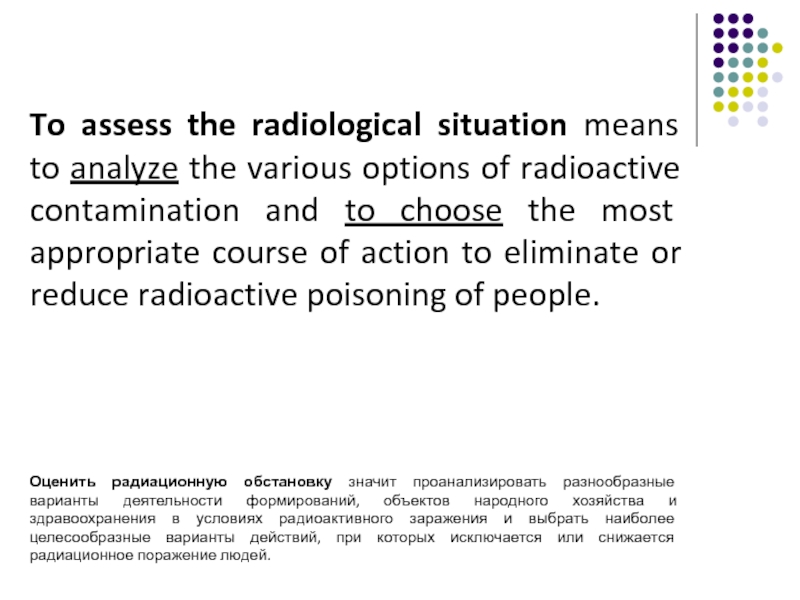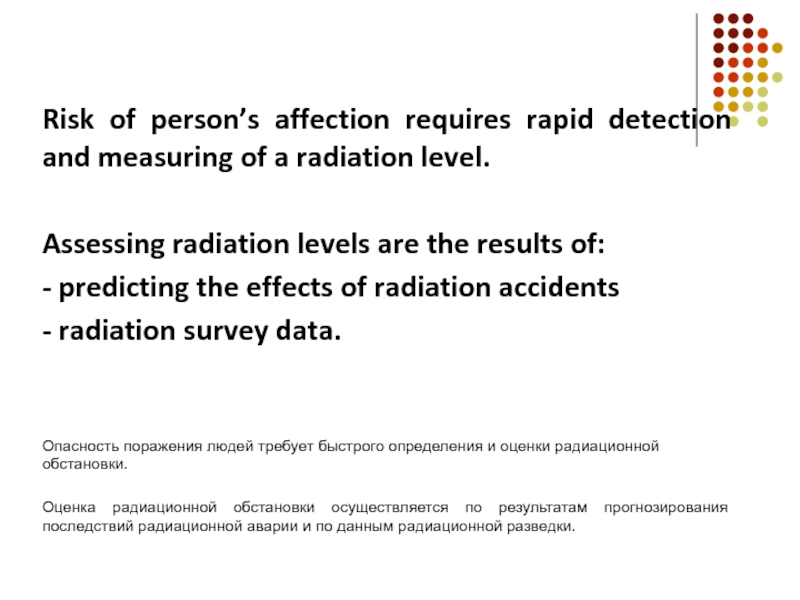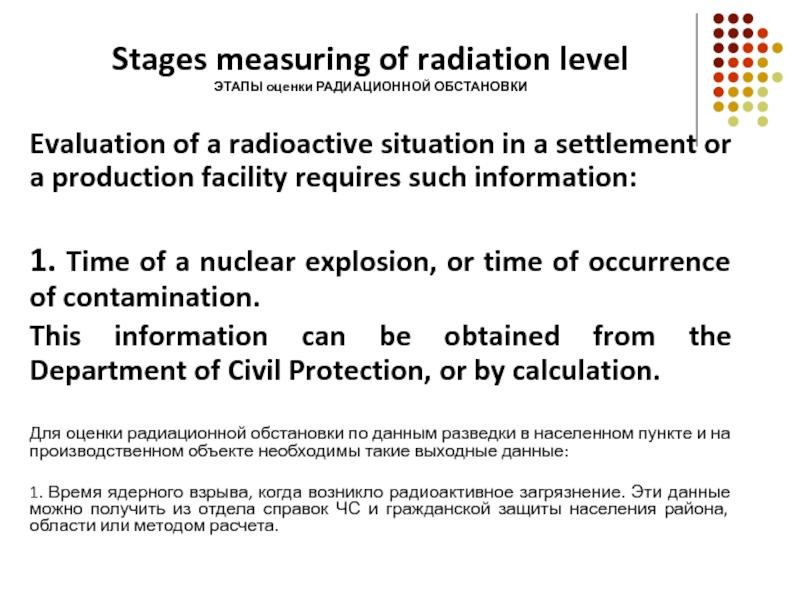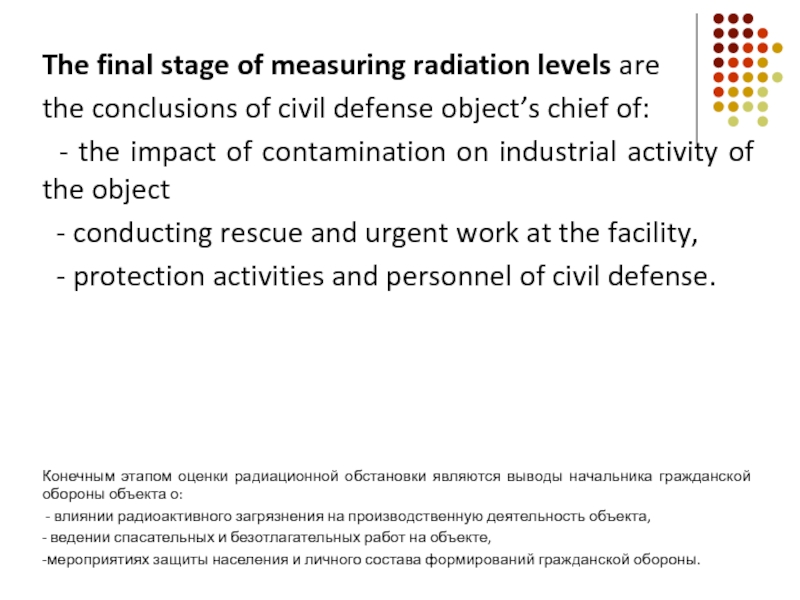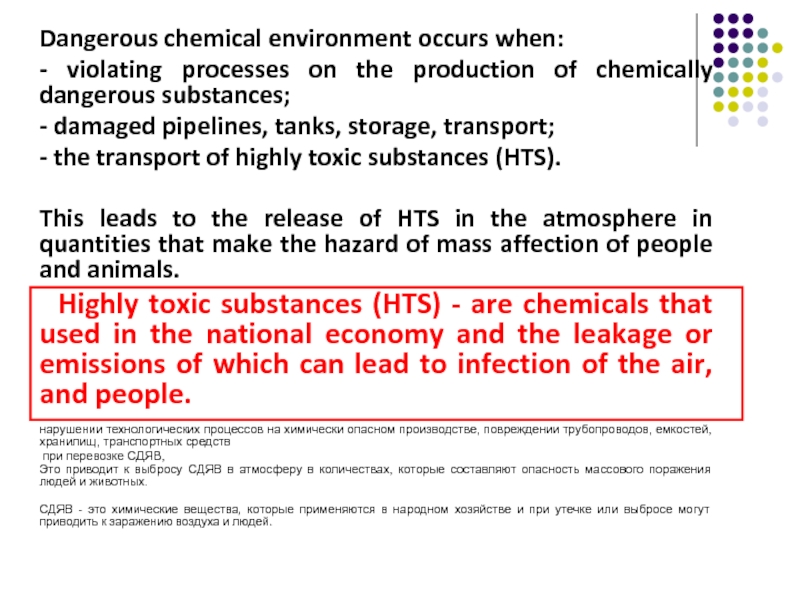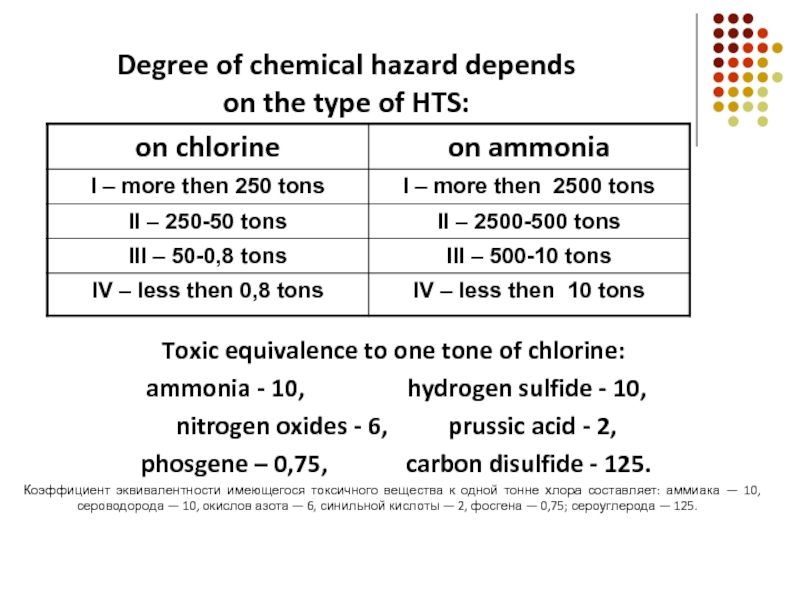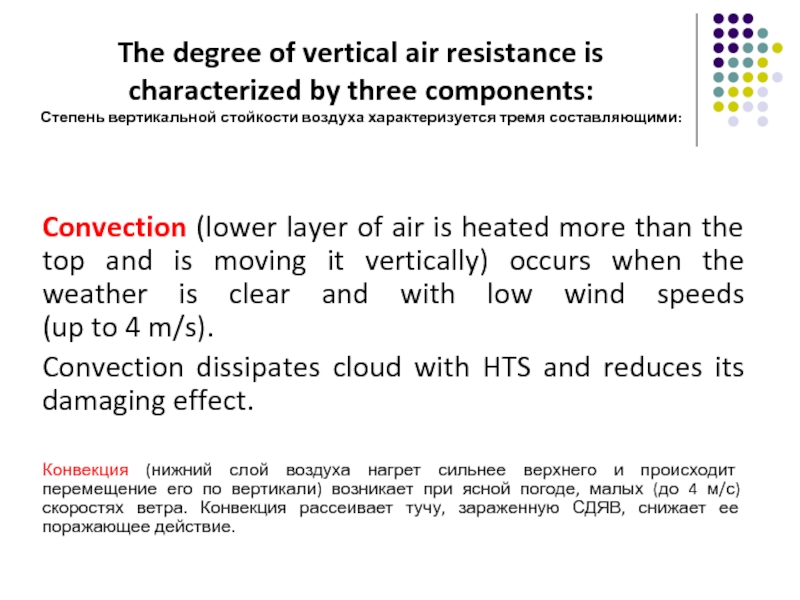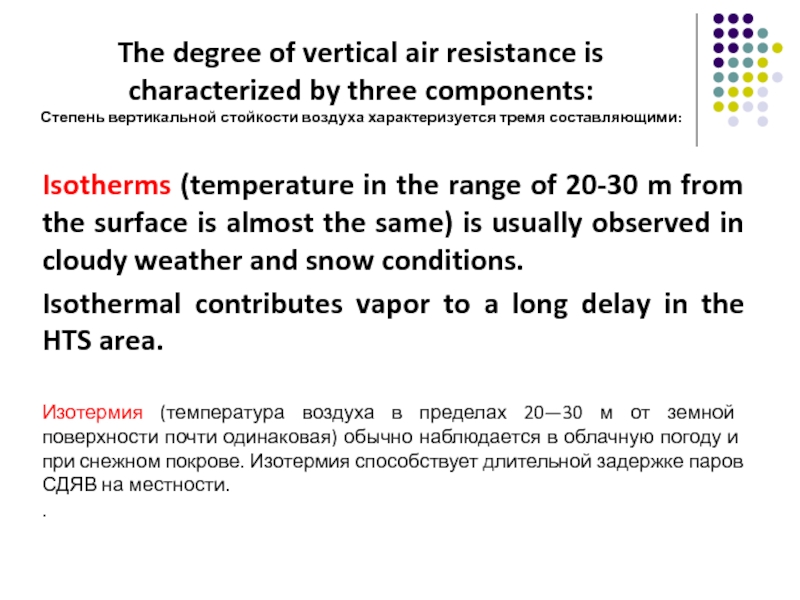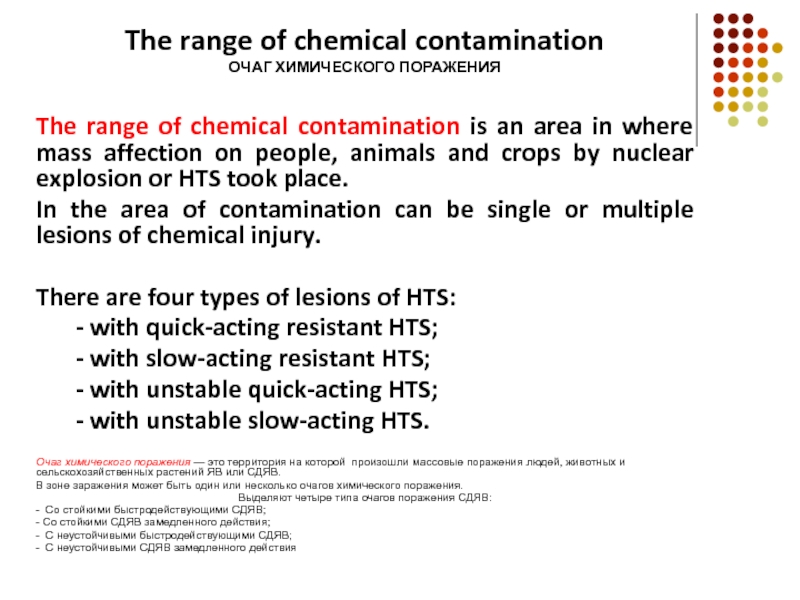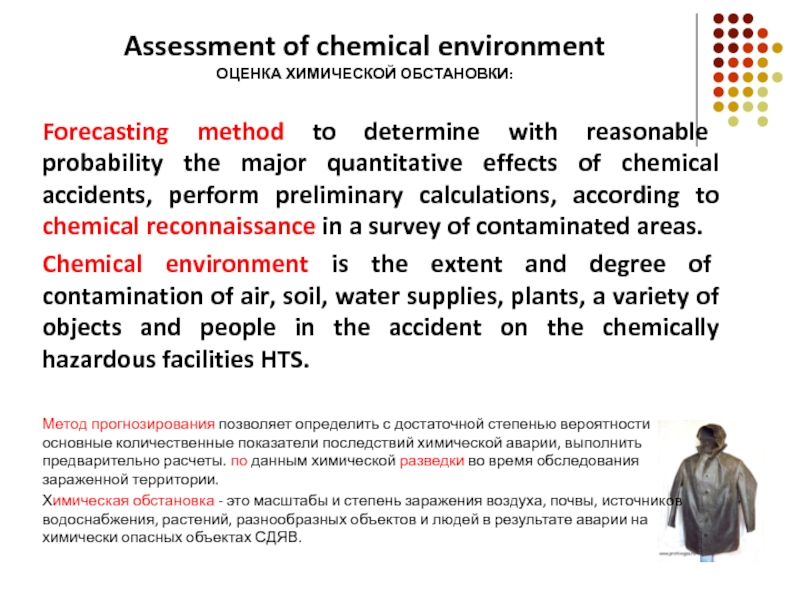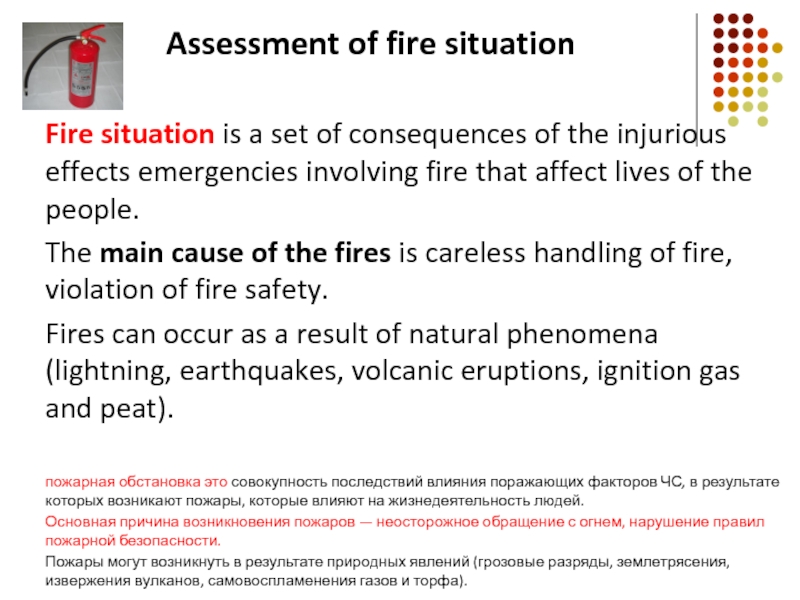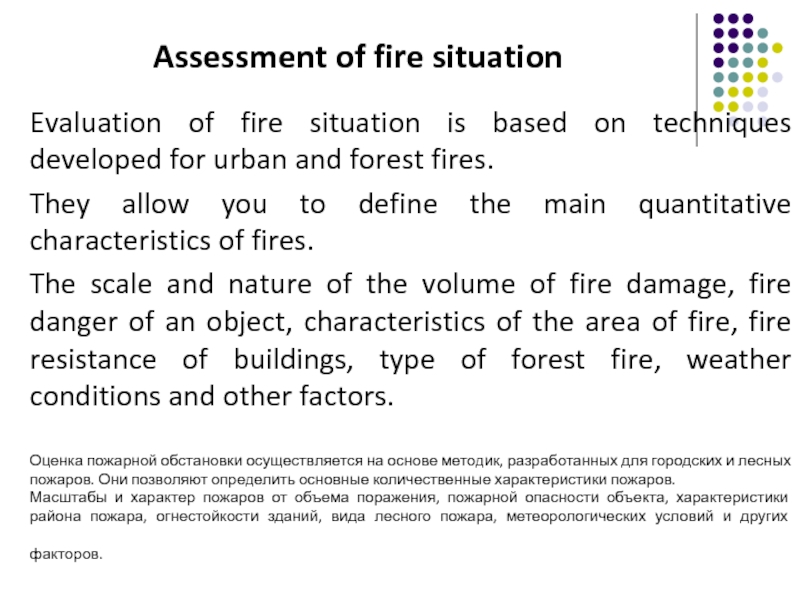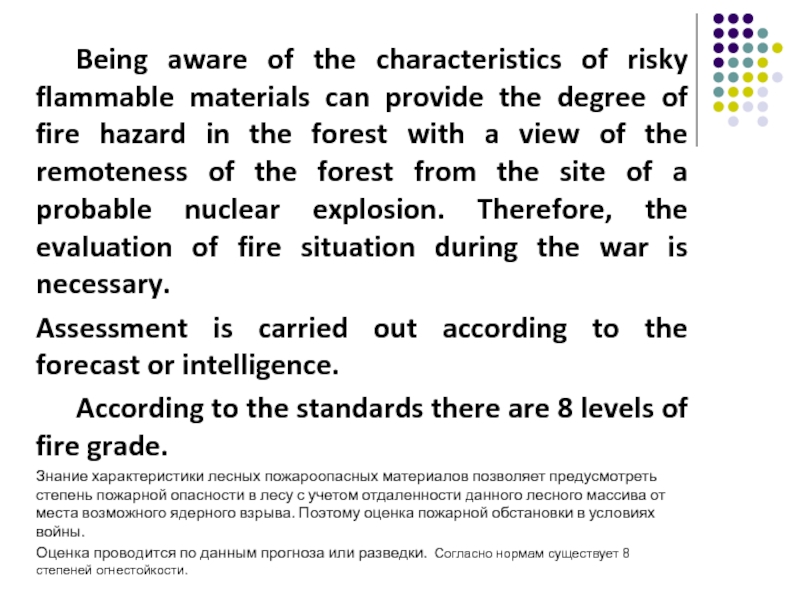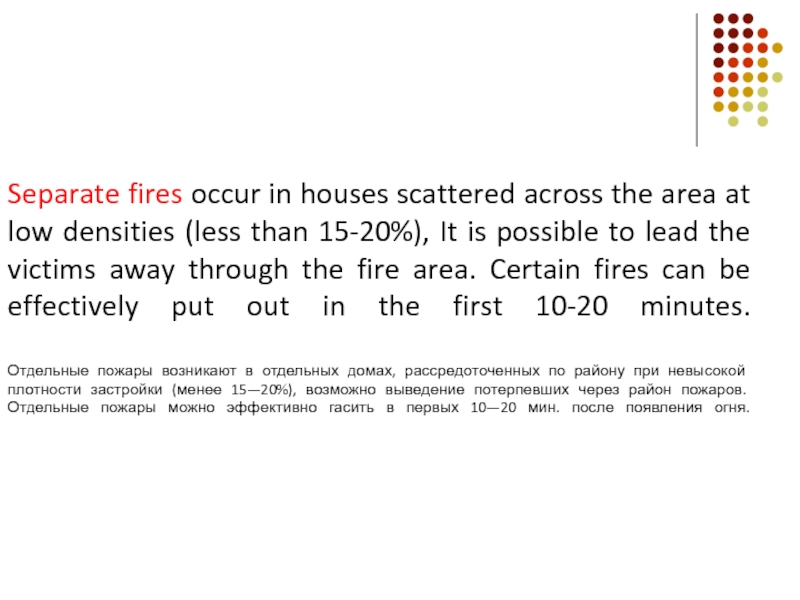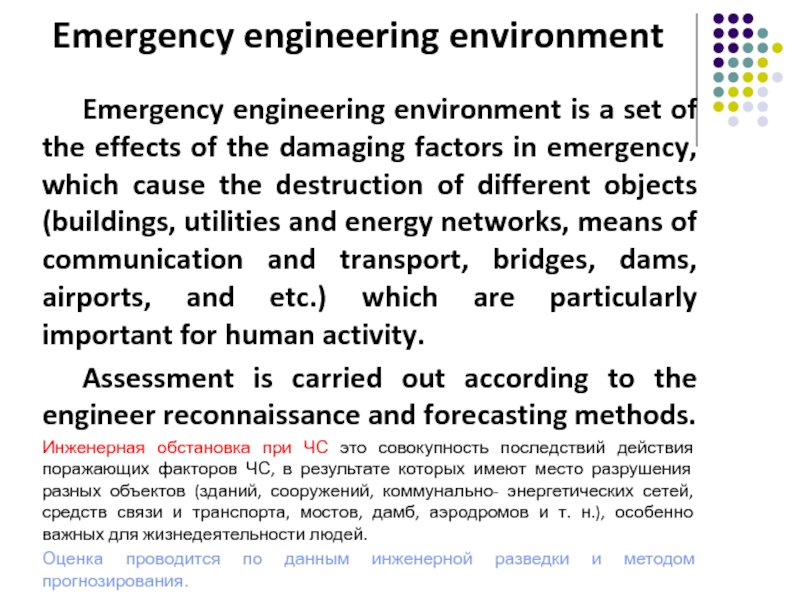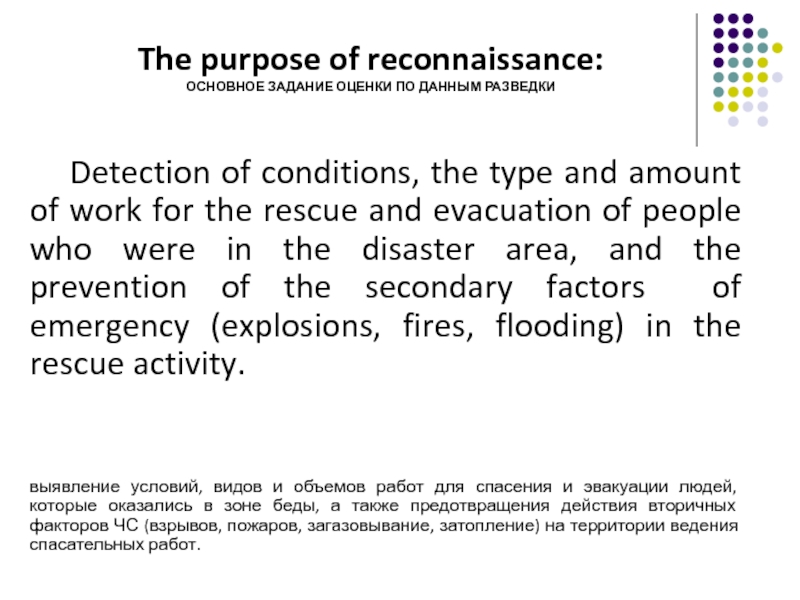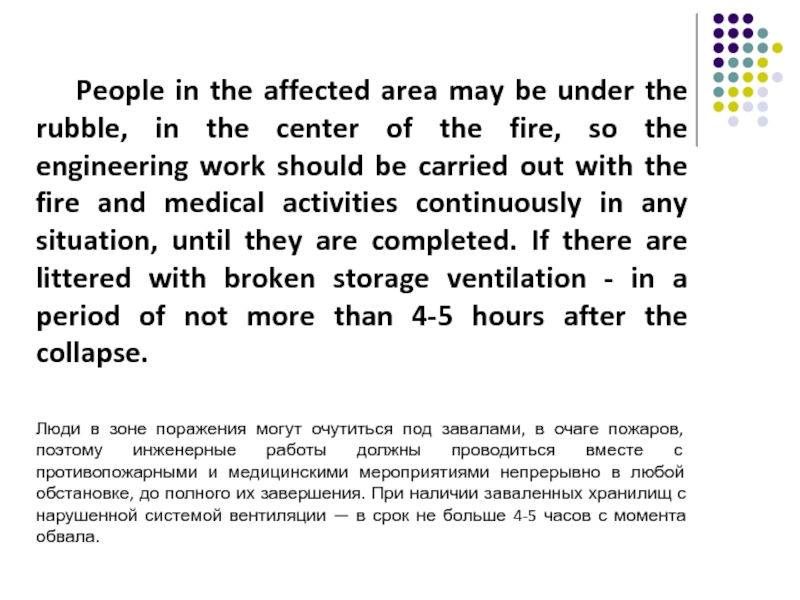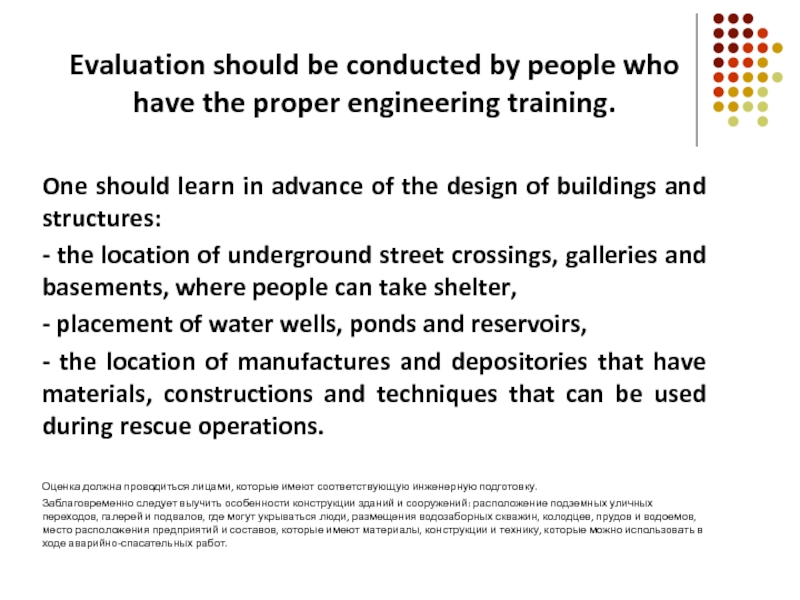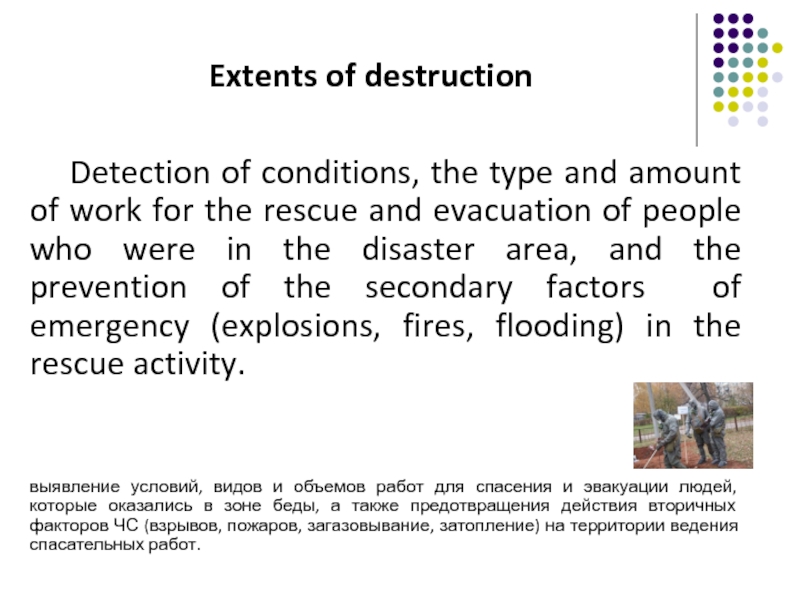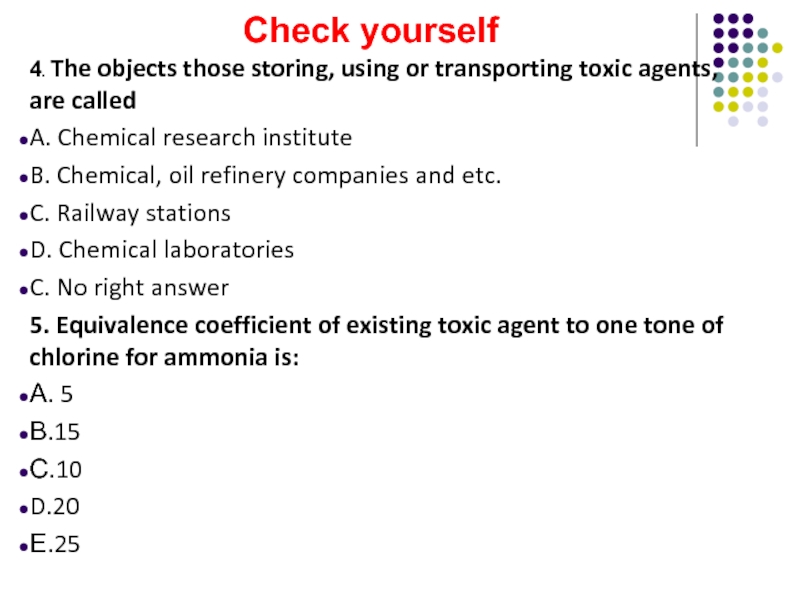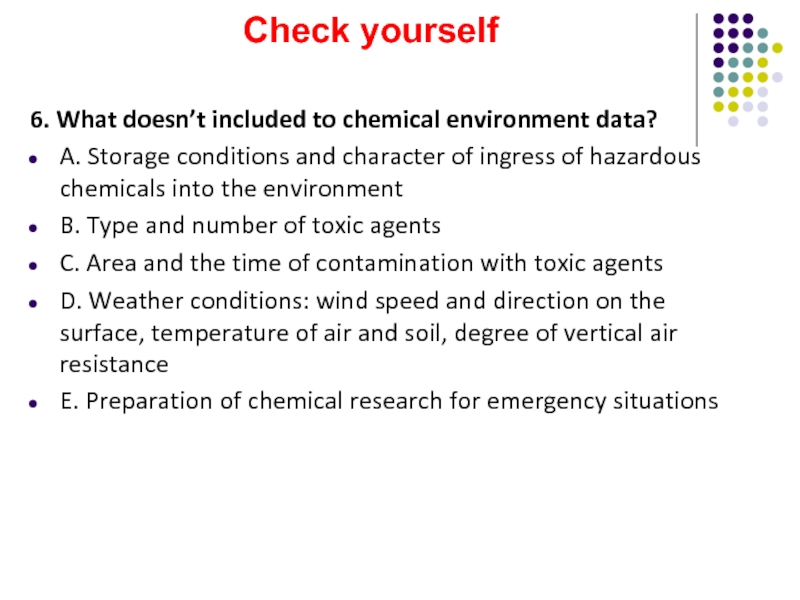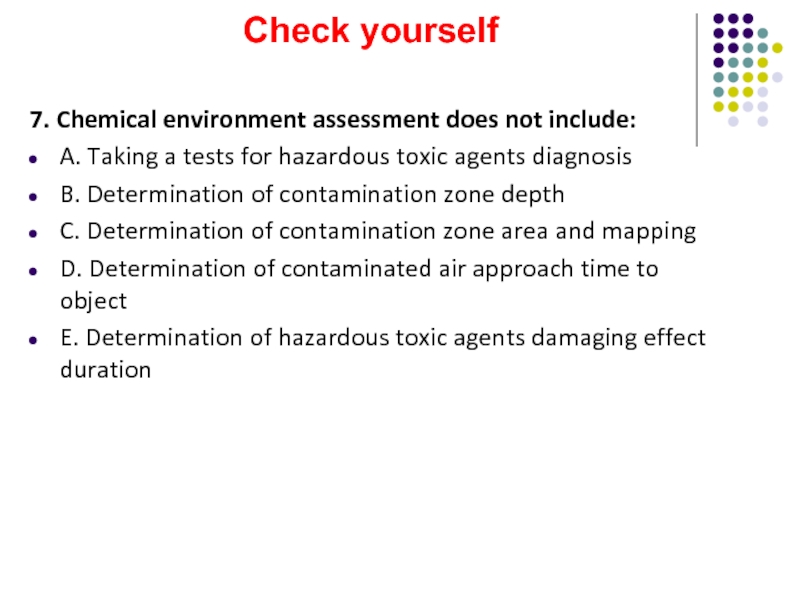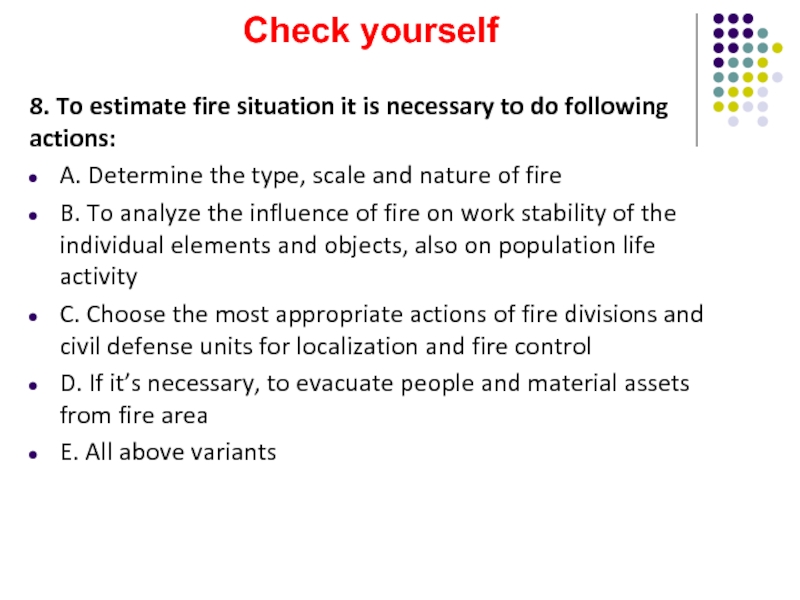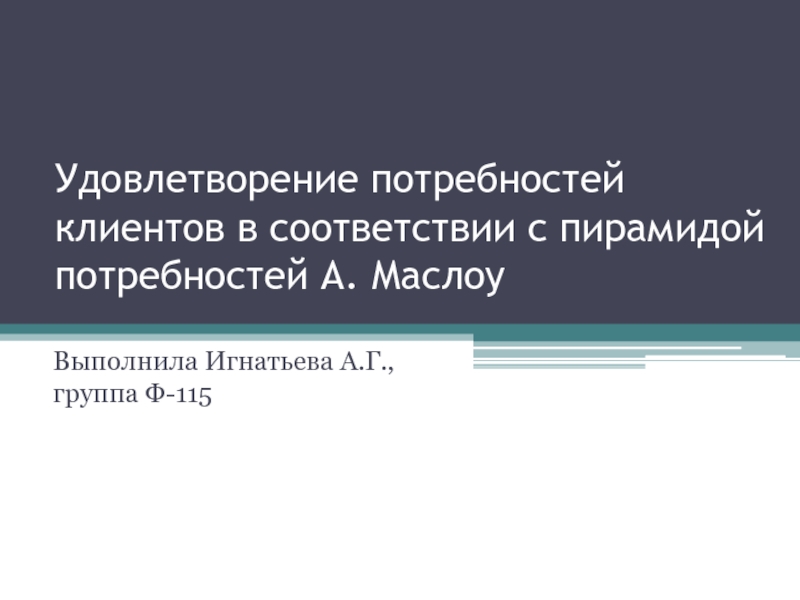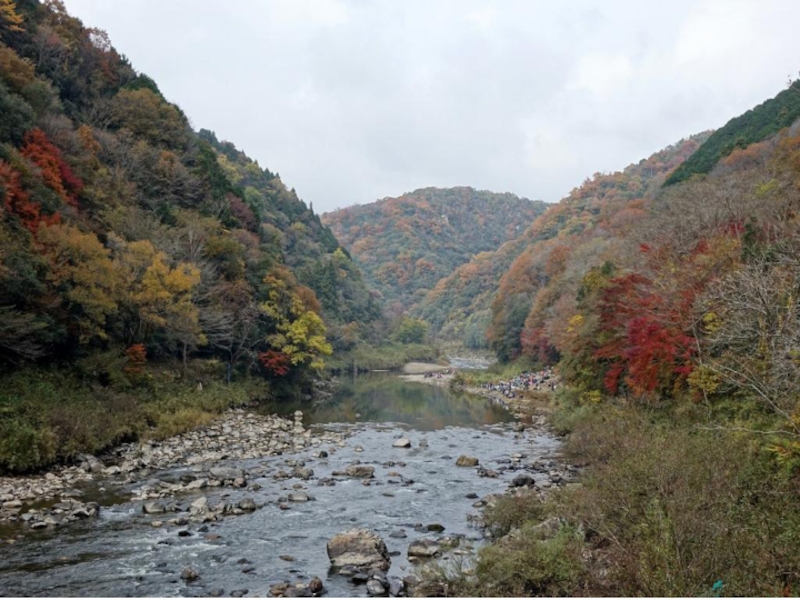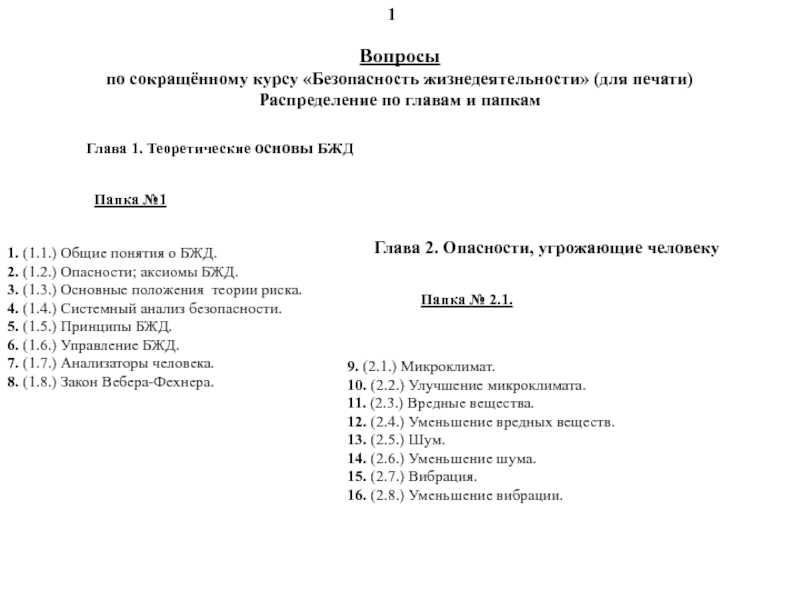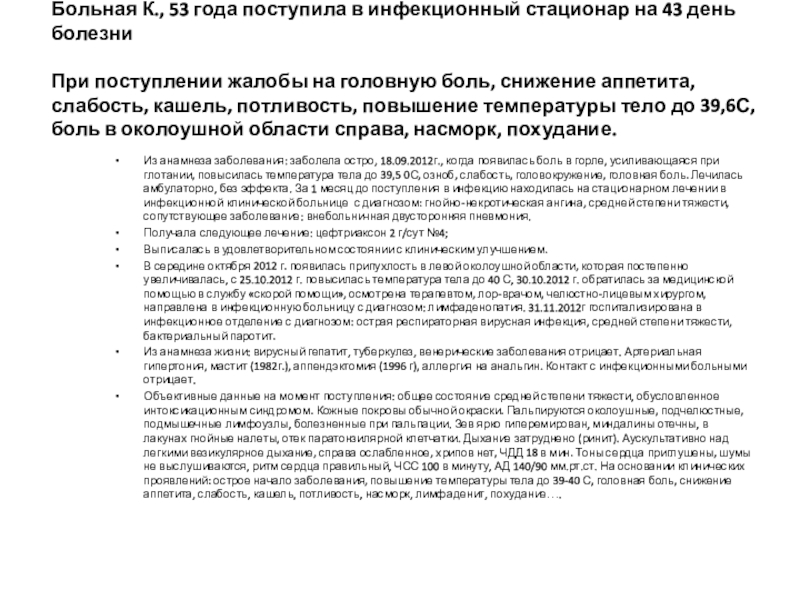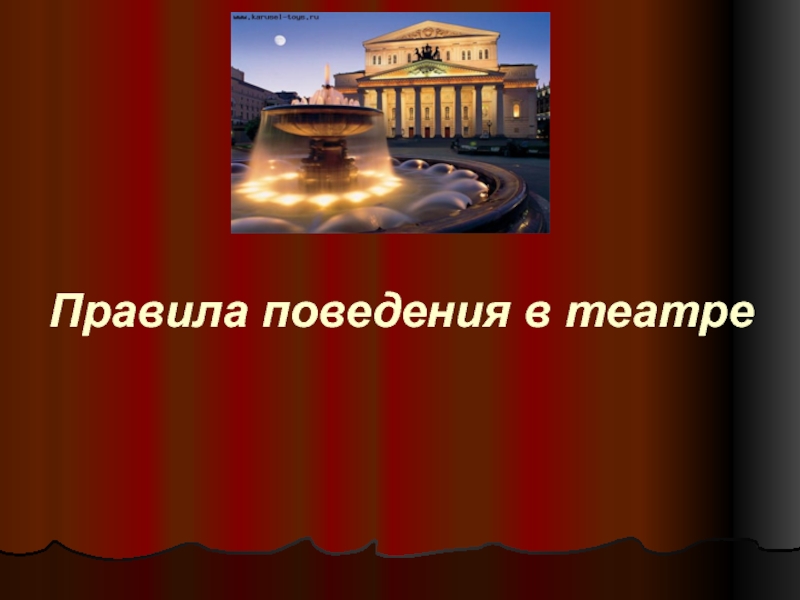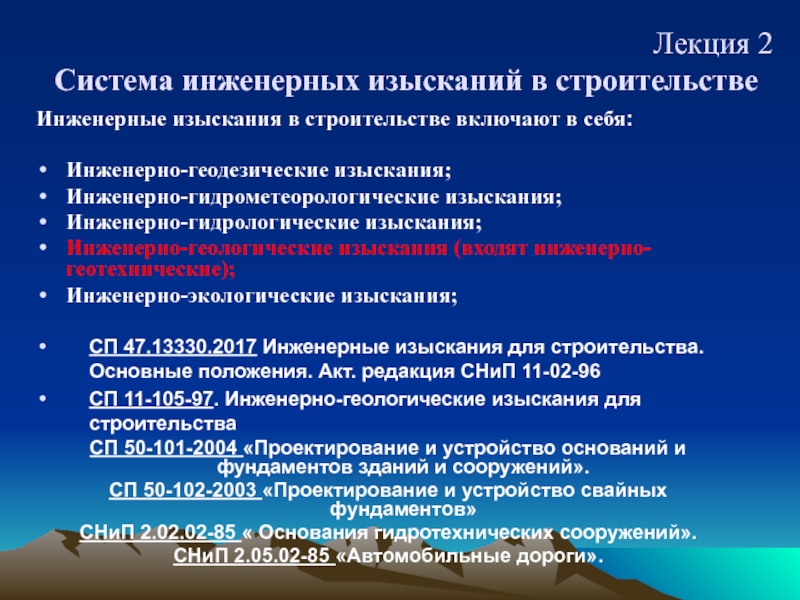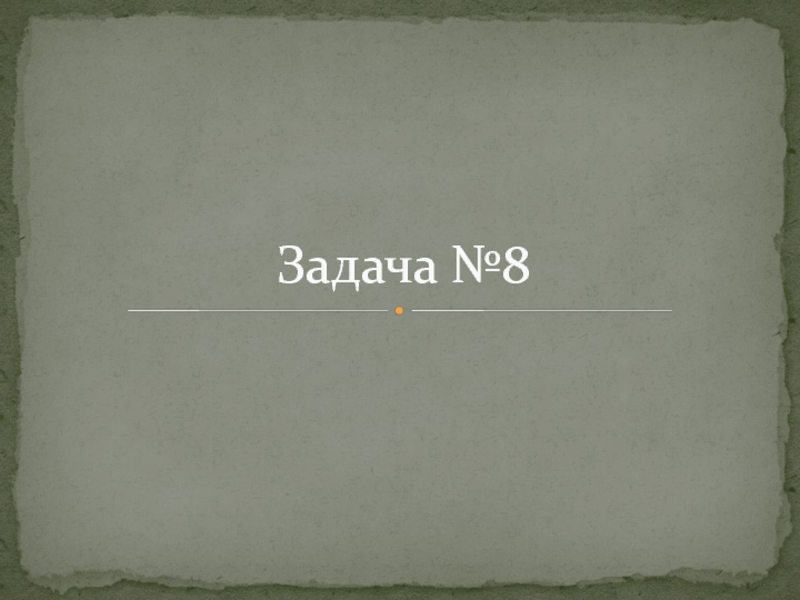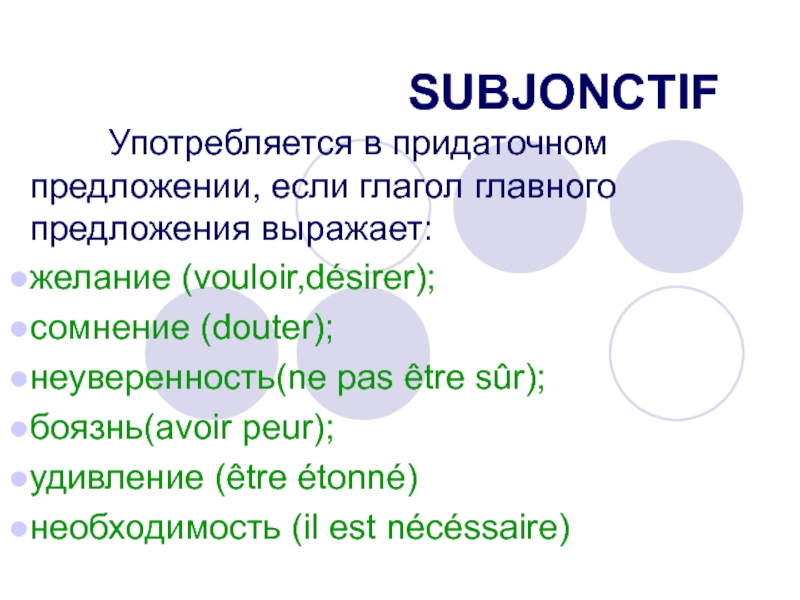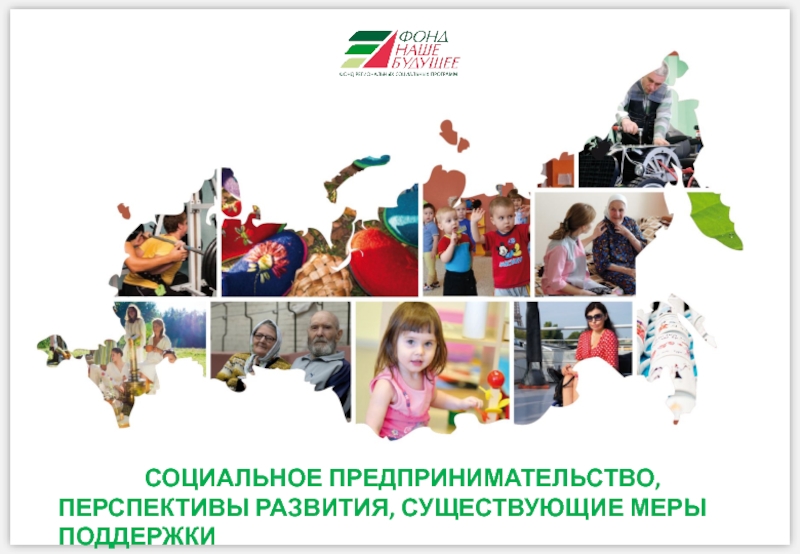Слайд 1ASSESSMENT OF THE SITUATION IN EMERGENCIES
Lecture #2
Слайд 2Radiation conditions is characterized as a scale and extent of
radioactive contamination that affects the duty of national economy, including
health facilities and vital activity of the population.
The purpose of measuring radiation level is to assess its possible impact on the availability of workers, employees, work of civil defense, emergency medical teams and population’s vital activity.
Под радиационной обстановкой понимают масштабы и степень радиоактивного заражения местности, которые влияют на работу объектов народного хозяйства, в том числе объектов здравоохранения, и жизнедеятельность населения.
Целью оценки радиационной обстановки является определение возможного влияния ее на работоспособность рабочих, служащих, работу формирований гражданской обороны, бригад экстренной медицинской помощи и жизнедеятельность населения.
Слайд 3To assess the radiological situation means to analyze the various
options of radioactive contamination and to choose the most appropriate
course of action to eliminate or reduce radioactive poisoning of people.
Оценить радиационную обстановку значит проанализировать разнообразные варианты деятельности формирований, объектов народного хозяйства и здравоохранения в условиях радиоактивного заражения и выбрать наиболее целесообразные варианты действий, при которых исключается или снижается радиационное поражение людей.
Слайд 4Risk of person’s affection requires rapid detection and measuring of
a radiation level.
Assessing radiation levels are the results of:
-
predicting the effects of radiation accidents
- radiation survey data.
Опасность поражения людей требует быстрого определения и оценки радиационной обстановки.
Оценка радиационной обстановки осуществляется по результатам прогнозирования последствий радиационной аварии и по данным радиационной разведки.
Слайд 5The process of forming a radioactive environment lasts several hours,
therefore, the evaluation of the radioactive situation is previously carried
out by the results of a radioactive contamination’s forecasting.
This allows to protect the population in advance.
Процесс формирования радиоактивной среды длится несколько часов,
поэтому предварительно проводят оценку радиационной обстановки по результатам прогнозирования радиоактивного заражения местности.
Это позволяет заблаговременно, то есть к подходу радиоактивного облака провести мероприятия по защите населения.
Слайд 6Stages measuring of radiation level
ЭТАПЫ оценки РАДИАЦИОННОЙ ОБСТАНОВКИ
Evaluation of a
radioactive situation in a settlement or a production facility requires
such information:
1. Time of a nuclear explosion, or time of occurrence of contamination.
This information can be obtained from the Department of Civil Protection, or by calculation.
Для оценки радиационной обстановки по данным разведки в населенном пункте и на производственном объекте необходимы такие выходные данные:
1. Время ядерного взрыва, когда возникло радиоактивное загрязнение. Эти данные можно получить из отдела справок ЧС и гражданской защиты населения района, области или методом расчета.
Слайд 7
2. Radiation levels at location and time of transmission.
Since the
measurements of radiation levels at location are not held at
the same time, it is useful to perform an assessment of radiation levels in one hour after a nuclear explosion.
2. Уровень радиации на объекте и время излучения.
Так как измерения уровней радиации на объекте проводятся не одновременно, целесообразно при оценки уровней радиации привести к 1 часу после ядерного взрыва.
Stages measuring of radiation level
Слайд 83. Coefficient of attenuation of radiation (by buildings, structures, warehouses,
shelters, vehicles).
For this purpose, the average values of attenuation coefficients
obtained from the calculation.
However, it is more reliable to detalize these factors after radioactive fallout by assessment the levels of radiation inside the building, where people are present, and indoor at a distance of about 20-30 m from the building:
K(at) = R(indoor) / R(inside the building)
The interval between the two measurements should not exceed 2-3 minutes.
3. Коэффициент ослабления радиации (постройками, сооружениями, хранилищами, укрытиями, транспортными средствами).
Для этого используют средние значения коэффициентов ослабления, полученные в результате расчета.
Однако надежнее после выпадения радиоактивных веществ уточнить эти коэффициенты путем измерения уровней радиации внутри дома, в котором будут находиться люди, и на открытой местности на расстоянии 20–30 м от дома (сооружения):
К осл = Р откр / Р дом Р откр - уровень радиации на открытой местности;
Р дом - уровень радиации в доме (сооружении). Интервал между двумя измерениями не должен превышать 2–3 мин.
Stages of measuring of radiation level
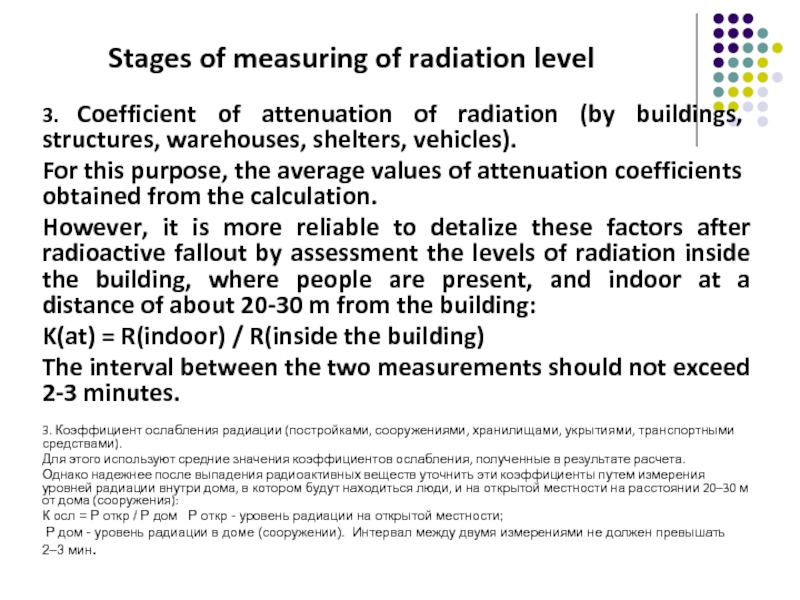
Слайд 9Stages of assessment of radiation level
4. Permissible dose. Dose is
established depending on the specific situation, the nature of the
activity that will fulfill the formation of civil defense.
It is important to know what will be received: a single or multiple exposures.
The fact that the accumulation of first dose is more intense, and therefore the first four days of the dose should be divided in corresponding proportion must be taken into account.
4. Допустимые дозы облучения. Дозы устанавливают в зависимости от конкретной обстановки, характера задания, которое будут выполнять формирования гражданской обороны.
Необходимо учитывать какое будет получено облучение одноразовое или многоразовое.
Необходимо учитывать то, что сначала накопление дозы облучения происходит интенсивнее, поэтому установленную дозу первые четверо суток необходимо делить в соответствующей пропорции.
Слайд 10
The final stage of measuring radiation levels are
the conclusions
of civil defense object’s chief of:
- the impact of
contamination on industrial activity of the object
- conducting rescue and urgent work at the facility,
- protection activities and personnel of civil defense.
Конечным этапом оценки радиационной обстановки являются выводы начальника гражданской обороны объекта о:
- влиянии радиоактивного загрязнения на производственную деятельность объекта,
- ведении спасательных и безотлагательных работ на объекте,
-мероприятиях защиты населения и личного состава формирований гражданской обороны.
Слайд 11The main tasks of measuring radiation
in case of accident
at the nuclear power plant is:
Основными заданиями оценки радиационной обстановки
при аварии на АЭС является:
- control of dispersal of radioactive substances from the reactor;
- control of the spread of radioactive substances, the speed and
rate of the transfer;
- control of radionuclide contamination of agricultural lands, forest and water;
- control of radioactive substances in food, water;
- individual monitoring of the population and the personnel of
civil defense.
-контроль выброса радиоактивных веществ из реактора;
-контроль распространения радиоактивных веществ, скорость и масштаб их переноса;
-контроль загрязнения радионуклидами сельскохозяйственных и лесных угодий и водоемов;
-контроль содержания радиоактивных веществ в продуктах питания, воде;
-индивидуальный дозиметрический контроль населения и личного состава формирований гражданской обороны.
Слайд 12
Assessment of chemical environment during infection
Оценка химической обстановки при
заражении ядовитыми веществами
Dangerous chemical environment is a set of the
effects of chemical contamination by toxic substances or asphyxiates that affect the activity of manufacture, the formation of civil defense objects and population.
Химическая обстановка — это совокупность последствий химического заражения территории ядовитыми веществами или сильнодействующими удушающими веществами, которые влияют на деятельность объектов формирования гражданской обороны и население.
Слайд 13Dangerous chemical environment occurs when:
- violating processes on the production
of chemically dangerous substances;
- damaged pipelines, tanks, storage, transport;
- the
transport of highly toxic substances (HTS).
This leads to the release of HTS in the atmosphere in quantities that make the hazard of mass affection of people and animals.
Highly toxic substances (HTS) - are chemicals that used in the national economy and the leakage or emissions of which can lead to infection of the air, and people.
нарушении технологических процессов на химически опасном производстве, повреждении трубопроводов, емкостей, хранилищ, транспортных средств
при перевозке СДЯВ,
Это приводит к выбросу СДЯВ в атмосферу в количествах, которые составляют опасность массового поражения людей и животных.
СДЯВ - это химические вещества, которые применяются в народном хозяйстве и при утечке или выбросе могут приводить к заражению воздуха и людей.
Слайд 14- Chemical and petroleum industries.
- Enterprises that use ammonia and
chlorine (used in refrigeration, waterworks and water treatment facilities)
- Railway
station with trains to the HTS.
- Storage and bases with stocks of substances for disinfection, disinfestation of grain storage.
- Storage and bases with stocks of agricultural pesticides.
Предприятия химической, нефтеперерабатывающей, промышленности.
Предприятия, которые используют аммиак и хлор (в холодильных установках, водопроводных станция и очистительных сооружениях),
- Железнодорожные станции с составами с HTS.
- Склады и базы с запасами веществ для дезинфекции, дезинсекции, дератизации хранилищ с зерном.
- Склады и базы с запасами сельскохозяйственных ядохимикатов.
Objects of storage, usage and transporting of HTS
Слайд 15
Toxic equivalence to one tone of chlorine:
ammonia - 10,
hydrogen sulfide
- 10,
nitrogen oxides - 6, prussic acid - 2,
phosgene – 0,75, carbon disulfide - 125.
Коэффициент эквивалентности имеющегося токсичного вещества к одной тонне хлора составляет: аммиака — 10, сероводорода — 10, окислов азота — 6, синильной кислоты — 2, фосгена — 0,75; сероуглерода — 125.
Degree of chemical hazard depends
on the type of HTS:
Слайд 16The degree of chemical hazards of the object can be
determined by the number of people involved in the area
of possible contamination of HTS:
I degree of danger - more than 75,000 people;
II - (from 50 000 to 75 000 people);
III - the zone of possible damage beyond the
enterprise and its sanitary zone;
IV - zone of possible contamination is within
the enterprise.
Степень химической опасности объекта может быть выражена в количестве населения, которое попадает в зону возможного заражения в случае выброса (утечки) СДЯВ:
I степень опасности — свыше 75 000 людей;
II — (от 50 000 до 75 000 людей);
ІІІ — зона возможного поражения выходит за пределы предприятия и его санитарной зоны;
IV — зона возможного заражения не выходит за пределы предприятия.
Слайд 17
The degree of vertical air resistance is characterized by three
components:
Степень вертикальной стойкости воздуха характеризуется тремя составляющими:
Inversion (when the lower
layers of the upper air is colder) occurs when the weather is clear and with low wind speeds (up to 4 m/s).
Inversion prevents dispersal of air at height and create favorable conditions for the storage of high concentrations of HTS.
Инверсия (нижние слои воздуха холоднее верхних) возникает при ясной погоде, малых скоростях ветра (до 4 м/с). Инверсия препятствует рассеиванию воздуха на высоте и создает благоприятные условия для хранения высоких концентраций HTS
The degree of vertical air resistance is characterized by three components:
Степень вертикальной стойкости воздуха характеризуется тремя составляющими:
Слайд 18
The degree of vertical air resistance is characterized by three
components:
Степень вертикальной стойкости воздуха характеризуется тремя составляющими:
Convection (lower layer of
air is heated more than the top and is moving it vertically) occurs when the weather is clear and with low wind speeds (up to 4 m/s).
Convection dissipates cloud with HTS and reduces its damaging effect.
Конвекция (нижний слой воздуха нагрет сильнее верхнего и происходит перемещение его по вертикали) возникает при ясной погоде, малых (до 4 м/с) скоростях ветра. Конвекция рассеивает тучу, зараженную СДЯВ, снижает ее поражающее действие.
Слайд 19
The degree of vertical air resistance is characterized by three
components:
Степень вертикальной стойкости воздуха характеризуется тремя составляющими:
Isotherms (temperature in the
range of 20-30 m from the surface is almost the same) is usually observed in cloudy weather and snow conditions.
Isothermal contributes vapor to a long delay in the HTS area.
Изотермия (температура воздуха в пределах 20—30 м от земной поверхности почти одинаковая) обычно наблюдается в облачную погоду и при снежном покрове. Изотермия способствует длительной задержке паров СДЯВ на местности.
.
Слайд 20
The range of chemical contamination
ОЧАГ ХИМИЧЕСКОГО ПОРАЖЕНИЯ
The range of chemical
contamination is an area in where mass affection on people,
animals and crops by nuclear explosion or HTS took place.
In the area of contamination can be single or multiple lesions of chemical injury.
There are four types of lesions of HTS:
- with quick-acting resistant HTS;
- with slow-acting resistant HTS;
- with unstable quick-acting HTS;
- with unstable slow-acting HTS.
Очаг химического поражения — это территория на которой произошли массовые поражения людей, животных и сельскохозяйственных растений ЯВ или СДЯВ.
В зоне заражения может быть один или несколько очагов химического поражения.
Выделяют четыре типа очагов поражения СДЯВ:
- Со стойкими быстродействующими СДЯВ;
- Со стойкими СДЯВ замедленного действия;
- С неустойчивыми быстродействующими СДЯВ;
- С неустойчивыми СДЯВ замедленного действия
Слайд 21
Output data for the chemical environment is
ВЫХОДНЫМИ ДАННЫМИ ДЛЯ ХИМИЧЕСКОЙ
ОБСТАНОВКИ ЯВЛЯЮТСЯ:
- area and the time of contamination by toxic
substances (TS)
- type and amount of TS;
- level of protection of people, animals, food, water supply facilities;
- storage conditions and type of environmental releases of hazardous chemicals;
- topographical conditions of locality, the type of buildings, the presence of forest plantings in the path of contaminated air;
-weather conditions: wind speed and direction in the surface, the temperature of air and soil, the degree of vertical stability of the air.
район и время заражения ЯВ;
-тип и количество ЯВ;
-степень защищенности людей, животных, продуктов питания;
- объектов водоснабжения;
-условия хранения и характер попадания в окружающую среду опасных химических веществ;
-топографические условия местности, характер застройки, наличие лесных насаждений на пути распространения зараженного воздуха;
-метеоусловия: скорость и направление ветра в приземном слое, температура воздуха и почвы, степень вертикальной стойкости воздуха.
Слайд 22Assessment of chemical environment
ОЦЕНКА ХИМИЧЕСКОЙ ОБСТАНОВКИ:
Forecasting method to determine
with reasonable probability the major quantitative effects of chemical accidents,
perform preliminary calculations, according to chemical reconnaissance in a survey of contaminated areas.
Chemical environment is the extent and degree of contamination of air, soil, water supplies, plants, a variety of objects and people in the accident on the chemically hazardous facilities HTS.
Метод прогнозирования позволяет определить с достаточной степенью вероятности основные количественные показатели последствий химической аварии, выполнить предварительно расчеты. по данным химической разведки во время обследования зараженной территории.
Химическая обстановка - это масштабы и степень заражения воздуха, почвы, источников водоснабжения, растений, разнообразных объектов и людей в результате аварии на химически опасных объектах СДЯВ.
Слайд 23Assessment of chemical environment includes:
- determination of the depth zone
of infection;
- determination of the area of contamination zone and
drawing on the plan area;
- the timing of the approach of contaminated air to the object;
- determination of the duration of the damaging effect of HTS;
identification of possible human victims
определение глубины зоны заражения;
- определение площади зоны заражения и нанесения на план местности;
- определение времени подхода зараженного воздуха к объекту;
- определение длительности поражающей действия СДЯВ;
- определение возможных потерь людей.
Слайд 24Assessment of fire situation
Fire situation is a set of consequences
of the injurious effects emergencies involving fire that affect lives
of the people.
The main cause of the fires is careless handling of fire, violation of fire safety.
Fires can occur as a result of natural phenomena (lightning, earthquakes, volcanic eruptions, ignition gas and peat).
пожарная обстановка это совокупность последствий влияния поражающих факторов ЧС, в результате которых возникают пожары, которые влияют на жизнедеятельность людей.
Основная причина возникновения пожаров — неосторожное обращение с огнем, нарушение правил пожарной безопасности.
Пожары могут возникнуть в результате природных явлений (грозовые разряды, землетрясения, извержения вулканов, самовоспламенения газов и торфа).
Слайд 25Assessment of fire situation
Evaluation of fire situation is based on
techniques developed for urban and forest fires.
They allow you
to define the main quantitative characteristics of fires.
The scale and nature of the volume of fire damage, fire danger of an object, characteristics of the area of fire, fire resistance of buildings, type of forest fire, weather conditions and other factors.
Оценка пожарной обстановки осуществляется на основе методик, разработанных для городских и лесных пожаров. Они позволяют определить основные количественные характеристики пожаров.
Масштабы и характер пожаров от объема поражения, пожарной опасности объекта, характеристики района пожара, огнестойкости зданий, вида лесного пожара, метеорологических условий и других факторов.
Слайд 26 Being aware of the characteristics of risky flammable materials can
provide the degree of fire hazard in the forest with
a view of the remoteness of the forest from the site of a probable nuclear explosion. Therefore, the evaluation of fire situation during the war is necessary.
Assessment is carried out according to the forecast or intelligence.
According to the standards there are 8 levels of fire grade.
Знание характеристики лесных пожароопасных материалов позволяет предусмотреть степень пожарной опасности в лесу с учетом отдаленности данного лесного массива от места возможного ядерного взрыва. Поэтому оценка пожарной обстановки в условиях войны.
Оценка проводится по данным прогноза или разведки. Согласно нормам существует 8 степеней огнестойкости.
Слайд 27 The main characteristics of fire:
- type,
- scale or density,
- development
and propagation speed, thermal radiation,
- burning period,
- air temperature,
- zone
of smoke pollution, etc.
Types of fire:
separate, massive, solid, fire storm, forest, desert, peat, smoldering, burning in the rubble.
Основные характеристики пожара:
вид,
масштаб или плотность,
развитие и скорость распространения, тепловая радиация,
длительность горения,
температура воздуха,
зона задымления и др.
Виды пожаров: отдельные, массовые, сплошные, огненный шторм, лесные, степные, торфяные, тление, горение в завалах.
Слайд 28Separate fires occur in houses scattered across the area at
low densities (less than 15-20%), It is possible to lead
the victims away through the fire area. Certain fires can be effectively put out in the first 10-20 minutes.
Отдельные пожары возникают в отдельных домах, рассредоточенных по району при невысокой плотности застройки (менее 15—20%), возможно выведение потерпевших через район пожаров. Отдельные пожары можно эффективно гасить в первых 10—20 мин. после появления огня.
Слайд 29
Solid fires covering a large area (over 90%) at densities
of more than 20-30%, passing through the area of fire
is excluded.
Rescue and other urgent work can be carried out in 4 hours.
Solid fires can turn into a firestorm at continuous urban development, the absence of surface wind and low humidity, while they occur in several places. In this case, a strong pillar of flame, which creates air flow speed of 50 km/h, which are moving to the center of the burning area.
Massive fires - the collection of all types of fires.
The main task is the localization of the continuous fire area.
Сплошные пожары охватывают значительную территорию (свыше 90%) при плотности застройки свыше 20—30%, проход через район пожаров исключен. Спасательные и другие безотлагательные работы можно проводить через 4 часа.
Сплошные пожары могут превратиться в огненный шторм при сплошной городской застройке, отсутствию приземного ветра и малой влажности при одновременном их возникновении в нескольких местах. В этом случае образуется мощный столб пламени, которое формируется воздушными потоками со скоростью 50 км/час, которые двигаются к центру пылающего района.
Главное задание — локализация района сплошных пожаров.
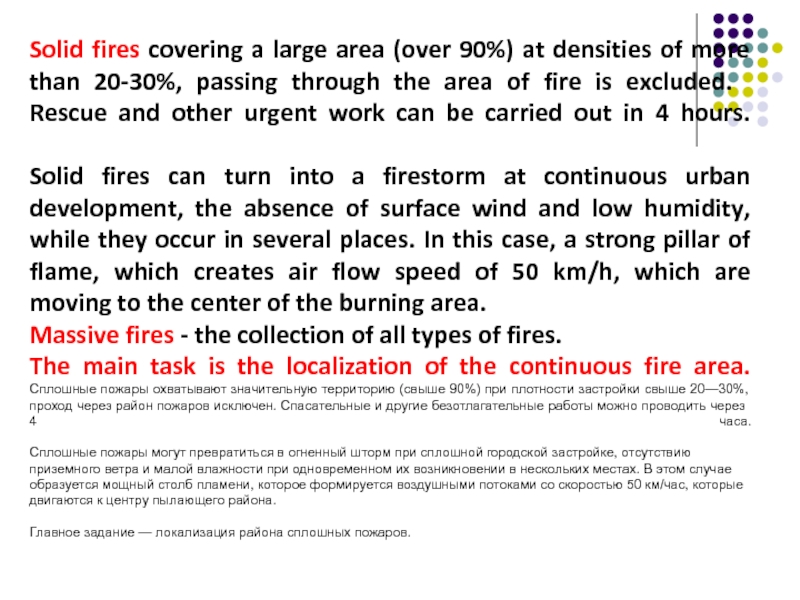
Слайд 30Emergency engineering environment
Emergency engineering environment is a set of
the effects of the damaging factors in emergency, which cause
the destruction of different objects (buildings, utilities and energy networks, means of communication and transport, bridges, dams, airports, and etc.) which are particularly important for human activity.
Assessment is carried out according to the engineer reconnaissance and forecasting methods.
Инженерная обстановка при ЧС это совокупность последствий действия поражающих факторов ЧС, в результате которых имеют место разрушения разных объектов (зданий, сооружений, коммунально- энергетических сетей, средств связи и транспорта, мостов, дамб, аэродромов и т. н.), особенно важных для жизнедеятельности людей.
Оценка проводится по данным инженерной разведки и методом прогнозирования.
Слайд 31The purpose of reconnaissance:
ОСНОВНОЕ ЗАДАНИЕ ОЦЕНКИ ПО ДАННЫМ РАЗВЕДКИ
Detection of
conditions, the type and amount of work for the rescue
and evacuation of people who were in the disaster area, and the prevention of the secondary factors of emergency (explosions, fires, flooding) in the rescue activity.
выявление условий, видов и объемов работ для спасения и эвакуации людей, которые оказались в зоне беды, а также предотвращения действия вторичных факторов ЧС (взрывов, пожаров, загазовывание, затопление) на территории ведения спасательных работ.
Слайд 32 People in the affected area may be under the rubble,
in the center of the fire, so the engineering work
should be carried out with the fire and medical activities continuously in any situation, until they are completed. If there are littered with broken storage ventilation - in a period of not more than 4-5 hours after the collapse.
Люди в зоне поражения могут очутиться под завалами, в очаге пожаров, поэтому инженерные работы должны проводиться вместе с противопожарными и медицинскими мероприятиями непрерывно в любой обстановке, до полного их завершения. При наличии заваленных хранилищ с нарушенной системой вентиляции — в срок не больше 4-5 часов с момента обвала.
Слайд 33Evaluation should be conducted by people who have the proper
engineering training.
One should learn in advance of the design of
buildings and structures:
- the location of underground street crossings, galleries and basements, where people can take shelter,
- placement of water wells, ponds and reservoirs,
- the location of manufactures and depositories that have materials, constructions and techniques that can be used during rescue operations.
Оценка должна проводиться лицами, которые имеют соответствующую инженерную подготовку.
Заблаговременно следует выучить особенности конструкции зданий и сооружений: расположение подземных уличных переходов, галерей и подвалов, где могут укрываться люди, размещения водозаборных скважин, колодцев, прудов и водоемов, место расположения предприятий и составов, которые имеют материалы, конструкции и технику, которые можно использовать в ходе аварийно-спасательных работ.
Слайд 34Extents of destruction
Detection of conditions, the type and amount of
work for the rescue and evacuation of people who were
in the disaster area, and the prevention of the secondary factors of emergency (explosions, fires, flooding) in the rescue activity.
выявление условий, видов и объемов работ для спасения и эвакуации людей, которые оказались в зоне беды, а также предотвращения действия вторичных факторов ЧС (взрывов, пожаров, загазовывание, затопление) на территории ведения спасательных работ.
Слайд 35 Complete destruction is the destruction of all elements of the
buildings, including basements, death of people in them, the losses
amount is more than 70% of the value of fixed assets. Subsequent use of the facility is not possible.
Severe damage - is the destruction of the walls and floor levels, strain of them, the appearance of cracks in the walls, death of a large part of the people. Loss is about 30 to 70% of the value of fixed assets .
Limited use of buildings аnd restoration are possible.
Полные разрушения — это разрушения всех элементов зданий, в том числе и подвальных помещений, поражения людей, которые находятся в них, убытки составляют больше 70 % стоимости основных производственных фондов. Последующее использование объекта невозможно.
Сильные разрушения — это разрушения части стен и перекрытия этажей, деформация их, возникновение трещин в стенах, поражение значительной части людей, которые находятся в них. Убытки - 30 до 70% стоимости основных производственных фондов
. Возможно ограниченное использование зданий, которые сохранились. Возобновление возможно после капитального ремонта.
Levels of destructions
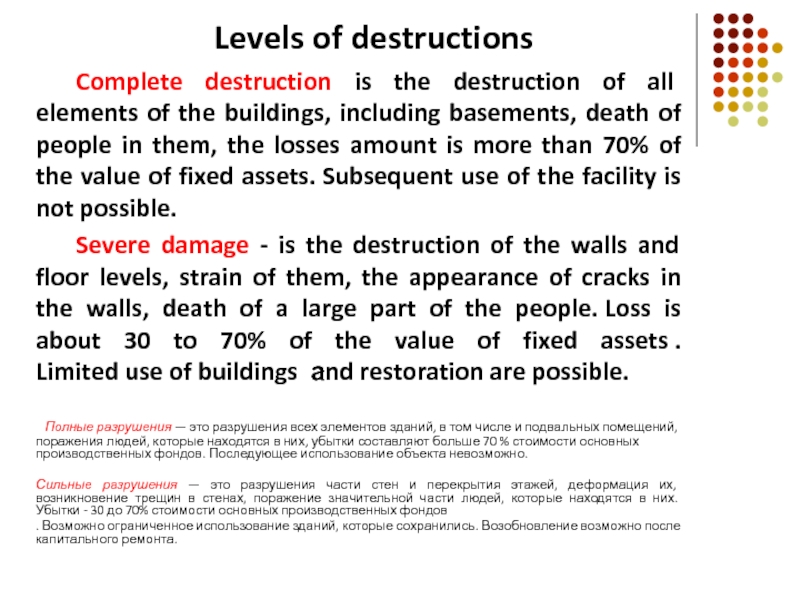
Слайд 36 Middle destruction - the destruction of mostly minor elements of
buildings and structures (roofs, windows, doors and walls), the appearance
of cracks in the walls. Basements remain, floors remain. People are most often affected by construction debris. Losses amount is about 10-30% of the cost of fixed assets.
Buildings need overhaul.
Weak destruction - the destruction of windows, doors and partitions. The affect of the people may be caused by rubble structures. Basements and ground floors are not damaged. They are suitable for use after the maintenance of buildings. Losses amount is about 10% of value of fixed assets).
Resumption after medium maintenance is possible.
Средние разрушения — это разрушение преимущественно второстепенных элементов зданий и сооружений (кровли, окон, дверей и перегородок), возникновения трещин в стенах. Подвальные помещения сохраняются, перекрытия остаются. Люди поражаются чаще обломками конструкций. Убытки составляют 10—30% стоимости основных производственных фондов .
Зданиям необходим капитальный ремонт.
Слабые разрушения — это разрушение окон, дверей и перегородок. Поражение людей возможно обломками конструкций. Подвалы и нижние этажи не повреждаются. Они пригодны для использования после текущего ремонта зданий. Убытки составляют до 10% стоимости основных производственных фонд). Возобновление возможно после среднего или текущего ремонта.
Levels of destructions

Слайд 37For revealing lesion focus is necessary:
Для выявления очага поражения необходимо
провести такие мероприятия:
Assessment of the conditions of entry into the
lesion.
Assessment of the destruction, conditions, types and amounts of engineering work in the dangerous area.
Assessment of the necessary measures to prevent explosions, fires, floods and other effects in progress.
The minimum duration of the work in the lesion depends on the conditions of the situation in the area, not less than 2-4 hours, and the maximum - no more than 10-12 hours for a change. All work on the rescue of victims should be conducted around the clock, continuous shifts. To ensure the continuous operation of mechanical means preparing 2-3 brigades of drivers and service teams (at least 2-3 people per car).
Оценить условия вхождения в очаг поражения.
Оценить разрушение, условия, виды и объемы инженерных работ в очаге.
и объемы работ из локализации аварий на КЭМ.
Оценить необходимые меры по предотвращению взрывов, пожаров, затоплений и других последствий в ходе работ. Минимальная длительность работы в очаге поражения определяется исходя из условий обстановки на местности, составляет не менее 2-4 часов, а максимальная — не больше 10-12 часов для одного изменения. Все работы по спасению пострадавших должны проводиться круглосуточно, непрерывно, посменно. Для обеспечения непрерывной работы средств механизации готовятся 2-3 бригады механиков-водителей и обслуживающих команд (не менее 2-3 человек на каждую машину).

Слайд 38Check yourself
1. Nuclear environment is:
A. Radiation level on an open
district
B. Scales and degree of radioactive infection of a district
C.
Radiation level in enclosed space
D. Number of affected people and animals
E. All above variants
2. For a radiating situation assessment in the settlement, it is necessary to know
A. Time of nuclear explosion
B. Radiation level on object and time of radiation
C. Coefficient of weakening of radiation by buildings
D. All above variants
E. No right answer
Слайд 39Check yourself
3. Chemical environment is:
A. Set of consequences of chemical
infection of the territory with toxic or strong suffocating agents
B.
Contamination degree with toxic or strong suffocating agents
C. Knowledge of toxic or strong suffocating agent’s properties
D. Set of consequences of chemical infection of the territory with toxic or strong suffocating agents, which influence on object of managing activity, formation of civil defense and population
E. All above variants
Слайд 40Check yourself
4. The objects those storing, using or transporting toxic
agents, are called
A. Chemical research institute
B. Chemical, oil refinery companies
and etc.
C. Railway stations
D. Chemical laboratories
C. No right answer
5. Equivalence coefficient of existing toxic agent to one tone of chlorine for ammonia is:
А. 5
В.15
С.10
D.20
Е.25
Слайд 41Check yourself
6. What doesn’t included to chemical environment data?
A. Storage
conditions and character of ingress of hazardous chemicals into the
environment
B. Type and number of toxic agents
C. Area and the time of contamination with toxic agents
D. Weather conditions: wind speed and direction on the surface, temperature of air and soil, degree of vertical air resistance
E. Preparation of chemical research for emergency situations
Слайд 42Check yourself
7. Chemical environment assessment does not include:
A. Taking a
tests for hazardous toxic agents diagnosis
B. Determination of contamination zone
depth
C. Determination of contamination zone area and mapping
D. Determination of contaminated air approach time to object
E. Determination of hazardous toxic agents damaging effect duration
Слайд 43Check yourself
8. To estimate fire situation it is necessary to
do following actions:
A. Determine the type, scale and nature of
fire
B. To analyze the influence of fire on work stability of the individual elements and objects, also on population life activity
C. Choose the most appropriate actions of fire divisions and civil defense units for localization and fire control
D. If it’s necessary, to evacuate people and material assets from fire area
E. All above variants
